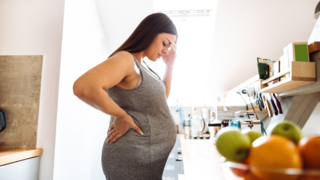In this article:
Still, when your belly starts to consistently bulge more to one side, or if you feel pressure, asymmetrical kicks, or visible shape distortion, you may wonder: Is this normal? Does it mean something is wrong with my uterus, my baby, or my core muscles?
Let’s break down the most common and a few less common reasons for a lopsided pregnancy belly.
What Does It Mean When Your Belly Looks Lopsided?
Pregnancy doesn’t shape your belly in a perfect, symmetrical way. From as early as the second trimester, your uterus grows upward and outward, but your baby's movements, your muscle tone, and even your posture influence how that shape appears.A lopsided bump usually means your baby has shifted to one side, especially during growth spurts or when they're stretching, rolling, or hiccupping. It might look more prominent when lying down, getting up, or when your abdominal muscles relax.
When a Lopsided Belly Is Completely Normal
Here’s why your belly might look uneven and why it’s usually no cause for concern:- Baby’s Position: Your baby isn’t static. They may prefer curling up on one side of your uterus (especially the right), and this makes your belly bulge asymmetrically.
- Anterior Placenta or Uterine Tilt: The position of the placenta or a naturally tilted uterus can shift the baby’s weight distribution.
- Braxton Hicks Contractions: These ‘practice’ contractions can temporarily firm up part of the uterus, making it look misshapen or tight on one side.
- Foetal Movement and Hiccups: A series of rhythmic jerks, small nudges, or full-on kicks on one side may stretch or firm up that area momentarily.
- Muscle Tone and Abdominal Separation (Diastasis Recti): The midline tissue between your abdominal muscles stretches out during pregnancy. Weakness or separation can make the belly bulge unevenly, depending on pressure from within.
Less Common Causes to Rule Out
Most of the time, an uneven bump is benign. But if your belly consistently looks distorted, unusually small or large on one side, or feels firm in a worrying way, a check-up is important. Possible causes include:- Uterine Anomalies: Congenital shapes like a bicornuate uterus may restrict space, causing the baby to settle asymmetrically. Some are diagnosed during fertility treatment or early ultrasounds.
- Foetal Position with Growth Concerns: If your baby is consistently lying transverse (sideways) or in breech beyond 34–36 weeks, and you’re noticing restricted movement on one side, your doctor may investigate growth patterns and cord placement.
- Amniotic Fluid Imbalance: Too little (oligohydramnios) or too much fluid (polyhydramnios) can distort the shape of the uterus. This often coexists with uneven belly pressure or unusual bump contours.
- Large Fibroids or Uterine Cysts: In rare cases, non-cancerous growths in the uterus can displace the baby or push the uterus into a distorted shape.
When to See a Doctor About It
Check with your gynaecologist or midwife if you notice any of the following:- Your bump has looked consistently uneven for weeks, not just hours.
- One side of your belly feels much harder than the other and doesn’t relax.
- You’re having pain, pressure, or discomfort on one side.
- Baby movements are only felt in a single spot, and overall movement has reduced.
- Your healthcare provider previously mentioned a uterine anomaly, fibroid, or growth restriction.
What You Can Do At Home
If you’re experiencing mild discomfort from a lopsided belly or just feel off-balance, these tips may help:- Change positions: Try lying on your left side or doing a gentle pelvic tilt. It may help the baby shift.
- Support your bump: Use a belly band or pregnancy pillow for extra abdominal support, especially if the weight feels uneven.
- Watch for movement patterns: If your baby tends to stay on one side, note if this pattern changes. It could help your doctor during checkups.
- Avoid sudden jerks: A lopsided baby might press harder on one nerve or ligament. Move slowly and adjust posture carefully to avoid round ligament pain.
Emotional Impact: Is This Just One More Thing to Worry About?
It’s easy to spiral, especially when your body feels foreign or unfamiliar. A lopsided belly can look strange in photos, feel uncomfortable in tight clothes, or trigger anxiety about what’s happening inside.But here’s what’s also true: most uneven bumps are harmless. And they shift. Sometimes, even multiple times a day. Your baby is practising stretching, flipping, and finding comfort, just like you.
Try to avoid comparing your belly’s shape to others. Every uterus, every baby, every abdominal wall is different. And just because your bump isn’t centre-aligned doesn’t mean your pregnancy is off track.
A lopsided pregnancy belly may look odd, but it’s usually just a sign that your baby is active, growing, and adjusting to the space they have. In rare cases, it may signal an underlying condition, but routine antenatal checks can catch anything concerning early. Trust your instincts, observe patterns, and never hesitate to bring it up with your care provider. Most often, it’s just one of the many perfectly normal, and slightly quirky, ways your body adapts to growing life.
FAQs on Why Your Pregnancy Belly Looks Lopsided And When to Worry
- Is it normal for my belly to be bigger on one side?
Yes, especially in the second and third trimesters. Babies often rest on one side, making that area bulge or feel heavier. - Can a lopsided belly mean twins?
Not necessarily. While multiple pregnancies can stretch the uterus unevenly, a singleton baby can also make your bump look asymmetrical depending on its position. - Should I worry if my baby always stays on one side?
Not usually. However, if movement becomes restricted or one side feels unusually firm or painful, consult your doctor. - Can sleeping positions affect the shape of my belly?
Yes. Lying or sitting in certain ways may cause your baby to shift, temporarily changing the shape of your bump.






